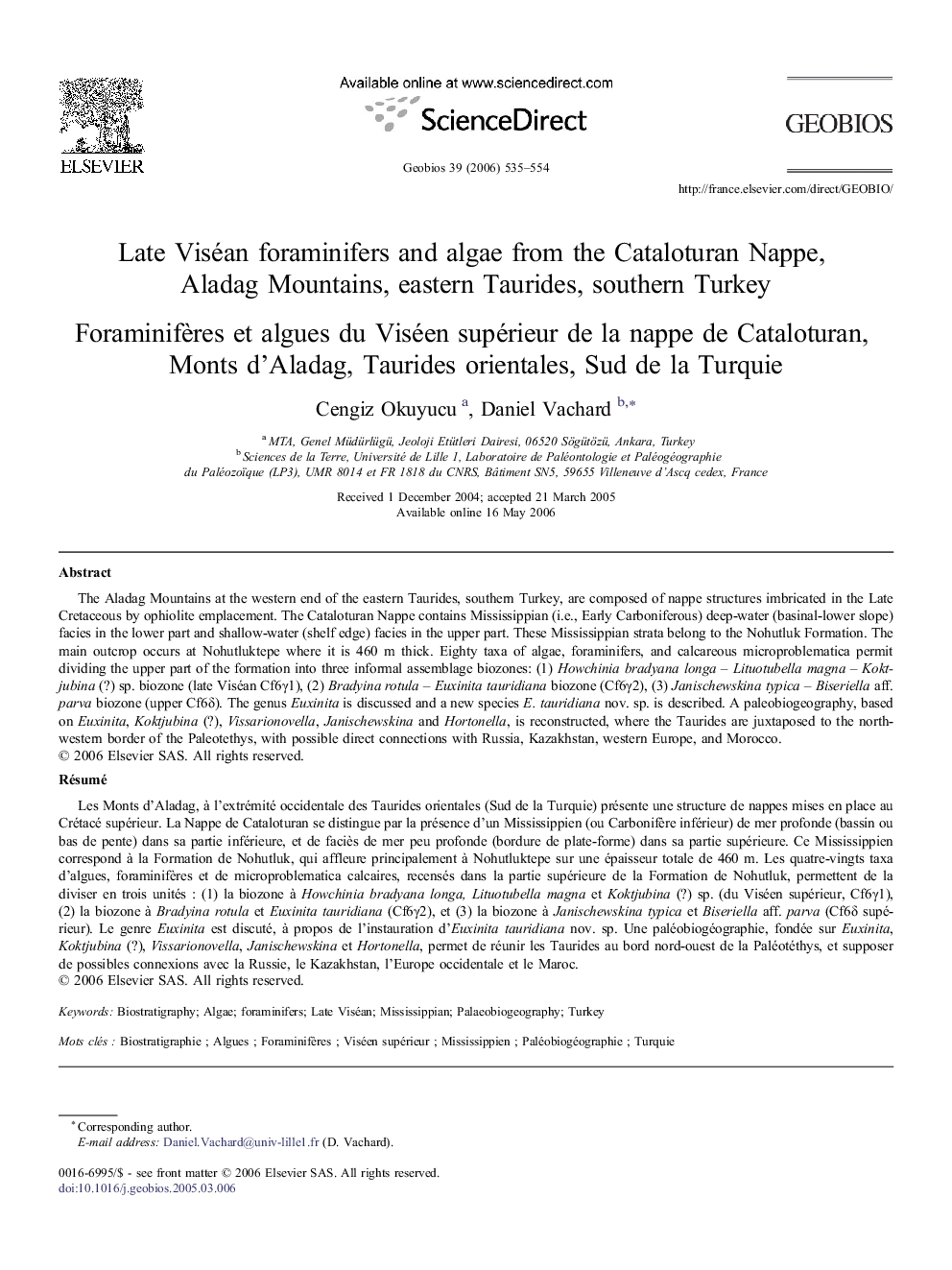| کد مقاله | کد نشریه | سال انتشار | مقاله انگلیسی | نسخه تمام متن |
|---|---|---|---|---|
| 4748496 | 1360111 | 2006 | 20 صفحه PDF | دانلود رایگان |

The Aladag Mountains at the western end of the eastern Taurides, southern Turkey, are composed of nappe structures imbricated in the Late Cretaceous by ophiolite emplacement. The Cataloturan Nappe contains Mississippian (i.e., Early Carboniferous) deep-water (basinal-lower slope) facies in the lower part and shallow-water (shelf edge) facies in the upper part. These Mississippian strata belong to the Nohutluk Formation. The main outcrop occurs at Nohutluktepe where it is 460 m thick. Eighty taxa of algae, foraminifers, and calcareous microproblematica permit dividing the upper part of the formation into three informal assemblage biozones: (1) Howchinia bradyana longa – Lituotubella magna – Koktjubina (?) sp. biozone (late Viséan Cf6γ1), (2) Bradyina rotula – Euxinita tauridiana biozone (Cf6γ2), (3) Janischewskina typica – Biseriella aff. parva biozone (upper Cf6δ). The genus Euxinita is discussed and a new species E. tauridiana nov. sp. is described. A paleobiogeography, based on Euxinita, Koktjubina (?), Vissarionovella, Janischewskina and Hortonella, is reconstructed, where the Taurides are juxtaposed to the northwestern border of the Paleotethys, with possible direct connections with Russia, Kazakhstan, western Europe, and Morocco.
RésuméLes Monts d'Aladag, à l'extrémité occidentale des Taurides orientales (Sud de la Turquie) présente une structure de nappes mises en place au Crétacé supérieur. La Nappe de Cataloturan se distingue par la présence d'un Mississippien (ou Carbonifère inférieur) de mer profonde (bassin ou bas de pente) dans sa partie inférieure, et de faciès de mer peu profonde (bordure de plate-forme) dans sa partie supérieure. Ce Mississippien correspond à la Formation de Nohutluk, qui affleure principalement à Nohutluktepe sur une épaisseur totale de 460 m. Les quatre-vingts taxa d'algues, foraminifères et de microproblematica calcaires, recensés dans la partie supérieure de la Formation de Nohutluk, permettent de la diviser en trois unités : (1) la biozone à Howchinia bradyana longa, Lituotubella magna et Koktjubina (?) sp. (du Viséen supérieur, Cf6γ1), (2) la biozone à Bradyina rotula et Euxinita tauridiana (Cf6γ2), et (3) la biozone à Janischewskina typica et Biseriella aff. parva (Cf6δ supérieur). Le genre Euxinita est discuté, à propos de l'instauration d'Euxinita tauridiana nov. sp. Une paléobiogéographie, fondée sur Euxinita, Koktjubina (?), Vissarionovella, Janischewskina et Hortonella, permet de réunir les Taurides au bord nord-ouest de la Paléotéthys, et supposer de possibles connexions avec la Russie, le Kazakhstan, l'Europe occidentale et le Maroc.
Journal: Geobios - Volume 39, Issue 4, July–August 2006, Pages 535–554